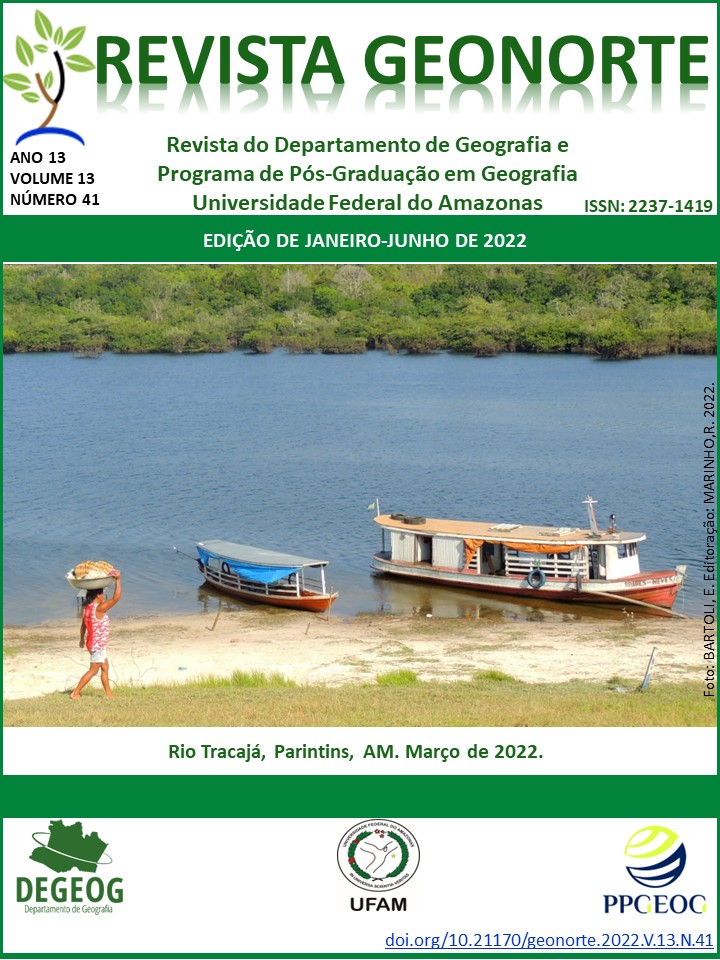RELAÇÃO ENTRE OS CONTROLES ESTRUTURAIS E A REDE DE DRENAGEM DA BACIA HIDROGRÁFICA DO RIO MUNDAÚ
DOI:
https://doi.org/10.21170/geonorte.2022.V.13.N.41.152.166Keywords:
Análise morfométrica; Geomorfologia; Dinâmica do relevoAbstract
Understanding the dynamics of the landscape has always been at the heart of geomorphological analyses. The watershed received great prominence due to their dynamics and their role in the evolution of the relief and its forms, making necessary an increasingly detailed approach to the relationships between the drainage networks and the relief. Thus, this research focused on the analysis of the Mundaú River Basin (BHRM) and four (04) of its sub basins, through the application of morphometric indices such as the Bifurcation Ratio (Rb), analysis of Hipsometric Curves and Integrals (HI) and the Drainage Basin Asymmetry Factor (FABD). Establishing relationships with the rocky substrate and the presence of faults and shear zones, it was found that, for the most part, the sub basins have their relief in a mature state, where there is a large percentage of geological homogeneity, predominantly metamorphic rocks, which do not have great structural influence on the drainage network. In addition, most su bbasins have tilt to the left flank, most likely influenced by the presence of faults and shear zones. Thus, it was possible to verify certain conditions that contribute to the understanding of the current relief stage, of BHRM as a whole, contributing to a better understanding of its dynamics.
Downloads
References
CORRÊA, A. C. B.; TAVARES, B. A. C.; MONTEIRO, K. A.; CAVALCANTI, L. C. S.; LIRA, D. R. Megageomorfologia e Morfoestrutura Do Planalto Da Borborema. Revista do Instituto Geológico, São Paulo, 31 (1/2), p.35-52, 2010.
CORREA, A. C. B.; MONTEIRO, K. A. REVISITANDO AS SUPERFÍCIES DE APLAINAMENTO: NOVOS ENFOQUES E IMPLICAÇÕES PARA A GEOMORFOLOGIA GEOGRÁFICA. Humboldt - Revista de Geografia Física e Meio Ambiente, v. 1, p. 1-26, 2021.
COX, R.T. Analysis of drainage basin symmetry as a rapid technique to identify areas of possible Quaternary tilt-block tectonics: an example from the Mississippi Embayment. Geol. Soc. Am. Bull, v. 106, p. 571-581, 1994.
CRICKMAY, C.H. (1959) A preliminary inquiry into the formulation and applicability of the geological principle of uniformity. Calgary, Evelyn de Mille Books, 53p.
CPRM - SERVIÇO GEOLÓGICO DO BRASIL. Brasília: CPRM, 2009.
DAVIS, W.M. 1889. The geographycal cycle. Geographycal Journal, v.14, p.481-504.
GROHMANN, C. H.; RICCOMINI, C. Análise digital de terreno e evolução de longo-termo de relevo do centro-leste brasileiro. Revista do Instituto de Geociências – USP. Geol. USP, Sér. cient., São Paulo, v. 12, n. 2, p. 12-150, 2012.
HACK, J. Interpretation of erosionsal topography in humid temperate regions. Amer. Journal of Science, v. 1, n. 4, p. 80-97, 1960.
HARE P.W; GARDNER I.W. Geomorphic indicators of vertical neotectonism along converging plate margins. Nicoya Peninsula, Costa Rica. In: Morisawa M & Hack J.T (eds.) Tectonic Geomorphology. Procedings 15th. Annual Binghamton Geomorphology Simp. 1984.
HORTON, R. E. Erosional development of streams and their drainage basins: hydrophysical approach to quantitative morphology. Geological Society of America Bulletin, v. 56, p. 275-370, 1945.
HOWARD, A.D. 1965. Geomorphologycal systems-equilibrium and dynamics. American Journal Science, v.263, p.302-312.
LASZLO, M. J., ROCHA, P.C. 2014. “COMPOSIÇÃO HIERARQUICA DOS CANAIS FLUVIAIS DAS BACIAS HIDROGRÁFICAS DOS RIOS AGUAPEÍ E PEIXE”. REVISTA GEONORTE 5 (20), 228 -32.
LEOPOLD, L. B., and Langbein, W. B., 1962, The concept of entropy in landscape evolution: U.S. Geol. Survey Prof. Paper 500-A, 20 p.
MONTEIRO, K. A.; CORRÊA, A. C. B. Análise dos perfis longitudinais dos rios Sirinhaem, una e Mundaú (PE/AL) a partir da aplicação do índice de Hack. Revista contexto geográfico Maceió-AL v. 1. N.1, p. 85 – 93, 2016.
PENCK (1953) Morphological analysis of land forms: a contribution to physical geology; trad. de Hella Czech. e Catherine C. Boswell. London, Macmillan. 429p.
SILVA, T.M; SANTOS, B.P. SISTEMAS DE DRENAGEM E EVOLUÇÃO DA PAISAGEM. Revista Geográfica Acadêmica v.4, n.1(2010).
STRAHLER, A. N., 1957, Quantitative analysis of watershed geomorphology: Am. Geophys. Union Trans., v. 38, no. 6, p. 913-920.
STRAHLER, A.N. Hypsometric (area-altitude) analysis and erosional topography. Geological Society of America Bulletin, v. 63, p. 1117-1142, 1952.
VARGAS, K.B.; SORDI, M.V. Integral Hipsométrica Aplicada A Bacias Hidrográficas Em Áreas De Borda Planáltica No Centro Norte Paranaense. XI SINAGEO. 2016.
VERSTAPPEN, H. T. Applied Geomorphology geomorphological surveys for environmental development. New York: Elsevier, 1983 (57–83).
Downloads
Published
How to Cite
Issue
Section
License
Autores que publicam nesta revista concordam com os seguintes termos:
- Autores mantém os direitos autorais e concedem à revista o direito de primeira publicação, com o trabalho simultaneamente licenciado sob a Licença Creative Commons Attribution que permite o compartilhamento do trabalho com reconhecimento da autoria e publicação inicial nesta revista.
- Autores têm autorização para assumir contratos adicionais separadamente, para distribuição não-exclusiva da versão do trabalho publicada nesta revista (ex.: publicar em repositório institucional ou como capítulo de livro), com reconhecimento de autoria e publicação inicial nesta revista.
- Autores têm permissão e são estimulados a publicar e distribuir seu trabalho online (ex.: em repositórios institucionais ou na sua página pessoal) a qualquer ponto antes ou durante o processo editorial, já que isso pode gerar alterações produtivas, bem como aumentar o impacto e a citação do trabalho publicado (Veja O Efeito do Acesso Livre).






